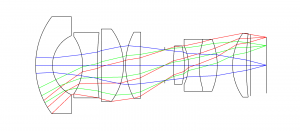Ultra Wide Angle lenses are indispensable in the world of imaging, offering a field of view that can extend up to 160°. These lenses are crucial for capturing vast scenes and intricate details, making them invaluable in a wide range of applications. From enhancing the visual appeal in photography to improving real-time monitoring in security and automotive systems, the versatility and complexity of these lenses are unmatched.
Wide-angle lenses are characterized by their short focal length and broad viewing angle, which make them ideal for capturing expansive scenes. These lenses excel at emphasizing foreground elements while still encompassing a wide background, resulting in unique and dynamic visual effects. Widely utilized in photography, wide-angle lenses are also integral to various fields such as security surveillance, automotive systems, and aerial imaging. Their ability to provide comprehensive coverage enhances safety, convenience, and real-time monitoring.

Wide-Angle Lens
The design of ultra-wide-angle lenses is complex, typically involving a combination of negative front groups and positive back groups of lenses. This structure is essential for achieving the necessary deflection and correction of light across the lens’s wide field of view. In many cases, the front group includes one or more negative lenses, which are crucial for light deflection. The complexity of this group often increases with the size of the field of view. The diaphragm is usually positioned within the rear group, which may also include double-bonded lenses to correct chromatic aberrations.
To ensure high-quality imaging, the lens coverage band spans from 435nm to 656nm, preventing chromatic issues like purple fringing. The lens’s Modulation Transfer Function (MTF) can achieve greater than 15%@250lp/mm, suitable for sensors with 2μm pixels. This high MTF value indicates excellent resolution and contrast in the lens’s output.

Design of Ultra Wide Angle Lenses
The lens design incorporates 10 pieces of glass, including 8 spherical lenses and 2 aspherical lenses. Aspherical lenses play a crucial role in improving image quality, simplifying the overall structure, and reducing the lens’s size. The compactness of the lens, with a length of just 28mm, makes it easy to integrate into various systems without compromising on performance.
Wide-angle lenses are essential in capturing large landscapes, intricate architectural details, and vast vistas, making them a staple in photography. However, their application extends far beyond traditional photography. In security surveillance, these lenses provide extensive coverage, enhancing monitoring capabilities. In the automotive industry, wide-angle lenses improve safety by offering a broader view of the surroundings. In aerial photography, they enable comprehensive coverage, crucial for mapping and surveillance tasks.
The advanced features of wide-angle lenses, such as compatibility with short-wave infrared for low-light conditions and digital distortion correction, further enhance their versatility. These lenses are continuously evolving, with design improvements ensuring they meet the diverse and growing demands of various imaging fields.
Ultra Wide Angle lenses, with their sophisticated design and extensive capabilities, are integral to modern imaging applications. Their ability to capture wide scenes and intricate details with high image quality makes them invaluable tools in both professional photography and industrial applications. At Avantier, we specialize in crafting custom wide-angle lenses tailored to your specific needs, including low distortion lenses with built-in correction. Contact us today to explore how we can support your next project.
Contact Shanghai Optics today! We’d be more than happy to discuss your projects and how to best bring them to fruition.